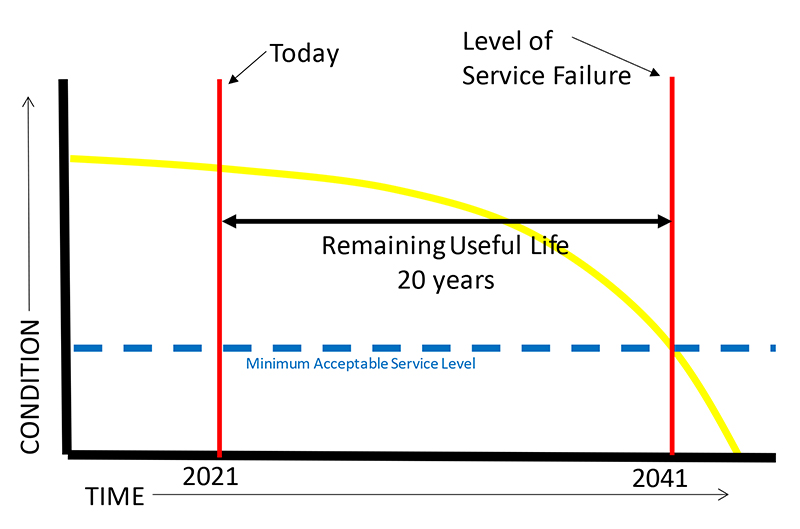Remaining Useful Life
All assets will eventually reach the end of their useful life. They will either reach that endpoint through use (in the case of mechanical assets) or time (in the case of passive assets.) There are many factors that affect the useful life of a given asset, such as installation conditions, materials, maintenance, level of usage, weather, and environment. Because of these site-specific characteristics, asset life must be viewed within the local context and the particular conditions of that system. The same asset in System A, located in the northeast, will not necessarily have the same useful life as System B, located in the desert southwest or System C, located near an ocean.
Since not all assets decay in the same way, assessing useful life must be done in a way that allows the assets to be viewed and prioritized equitably. For assets that have an indefinite life, such as natural assets (forest, stream, river), the remaining useful life may need to be assessed based on when investment is needed to keep the asset operating at its highest level. This could include controlled burns in forests or stream rehabilitation. For engineered green assets that improve over time and can be restored to full functionality, thus extending the useful life, restoration dates may need to be used. Other green assets may have a more typical useful life and that number should be used. The practice of establishing useful life for green assets is in its beginning phases and will improve over time.
Systems should use their experience with the assets as well as historical data to estimate the useful life remaining for existing assets. Knowledgeable individuals (operators, managers, maintenance personnel, engineers) should go through each asset and using their collective knowledge, provide their best guess estimate of how much longer the asset will last in service. The chart below illustrates the useful life remaining.
The condition is on the y axis and time is on the x axis. The blue line shows an example condition decay curve. The blue dashed line shows the minimum acceptable service level. To estimate the useful life, it is necessary to guess (best educated guess based on all that is known about the asset) when the asset will pass through the minimum acceptable service level. Then consider how many years from today until the asset meets that level. In this example, the asset has a 20-year remaining useful life.

Age is sometimes used as a proxy for useful life remaining but it is not the best method of determining useful life. It is likely to underestimate the time remaining, meaning assets can last longer than engineering estimates would show. Also, the same assets located in different areas of the system, subject to different environmental conditions, are unlikely to perform the same.